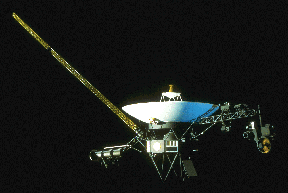This image shows Cordelia and Ophelia along with one of Uranus' rings.
Click on image for full size
Courtesy of NASA
Scientists Find Uranus Moons... Again?
News story originally written on March 9, 2000
Scientists just found two of Uranus' moons... again. Ophelia and Cordelia were first discovered by Voyager II in 1986. The moons are so small that they can't be detected from Earth. Scientists were tracking the tiny moons until the Hubble Space Telescope could be launched, but by the time Hubble had its sights on Uranus, Ophelia and Cordelia were lost.
So how did scientists find the lost moons? Ophelia and Cordelia are shepherding moons, which are moons that keep planetary rings together. Cordelia is just inside of one of Uranus' rings, with Ophelia following orbit on the outside. Together, they keep the particles that make up the ring in a tight loop.
Once they knew the orbits of the moons, scientists studied images from Hubble until they spotted Ophelia. Meanwhile, ripples in Uranus' rings led them to the location of Cordelia. This newest "discovery" once again names Uranus as the king of moons in our solar system with a total of 20.
You might also be interested in:

The rare arrangement of planets Jupiter, Saturn, Uranus, and Neptune in the 1980's made it possible for the Voyager spacecrafts to visit them over a 12 year span instead of the normal 30. They used gravity
...more
It was another exciting and frustrating year for the space science program. It seemed that every step forward led to one backwards. Either way, NASA led the way to a great century of discovery. Unfortunately,
...more
The Space Shuttle Discovery lifted off from Kennedy Space Center on October 29th at 2:19 p.m. EST. The weather was great as Discovery took 8 1/2 minutes to reach orbit. This was the United States' 123rd
...more
A moon was discovered orbiting the asteroid, Eugenia. This is only the second time in history that a satellite has been seen circling an asteroid. A special mirror allowed scientists to find the moon
...more
Will Russia ever put the service module for the International Space Station in space? NASA officials want an answer from the Russian government. The necessary service module is currently waiting to be
...more
A coronal mass ejection (CME) happened on the Sun early last month. The material that was thrown out from this explosion passed the ACE spacecraft. The SWICS instrument on ACE has produced a new and very
...more
J.S. Maini of the Canadian Forest Service called forests the "heart and lungs of the world." This is because forests filter air and water pollution, absorb carbon dioxide, release oxygen, and maintain
...more















